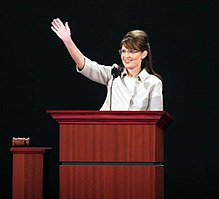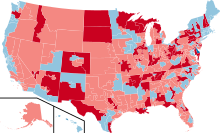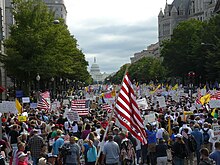Timeline of modern American conservatism
Defunct Newspapers Journals TV channels Websites Other Congressional caucuses Economics Gun rights Identity politics Nativist Religion Watchdog groups Youth/student groups Social media Miscellaneous Other This timeline of modern American conservatism lists important events, developments and occurrences that have affected conservatism in the United States.
Conservatives generally distrust the United Nations and Europe and apart from the libertarian wing favor a strong military and give enthusiastic support to Israel.
[1] Although conservatism has much older roots in American history, the modern movement began to gel in the mid-1930s when intellectuals and politicians collaborated with businessmen to oppose the liberalism of the New Deal led by President Franklin D. Roosevelt, newly energized labor unions and big-city Democratic machines.
After World War II, that coalition gained strength from new philosophers and writers who developed an intellectual rationale for conservatism.
In the 1980s, President Ronald Reagan rejuvenated the conservative Republican ideology, with tax cuts, greatly increased defense spending, deregulation, a policy of rolling back communism, a greatly strengthened military and appeals to family values and conservative Judeo-Christian morality.
[6] After the war, businessmen opposed to New Deal liberalism read Hayek, fight labor unions, and fund politicized think tanks such as American Enterprise Institute (founded 1943).
Demands for "law and order" escalate and the backlash causes disillusionment among working class whites with the liberalism of the Democratic Party.
Republican liberals, led by Nelson Rockefeller, argue for a strong federal role because it was morally right and politically advantageous.
[81]Historians Meg Jacobs and Julian Zelizer argue that the 1970s were characterized by "a vast shift toward social and political conservatism," as well as a sharp decline in the proportion of voters who identified with liberalism.
His foreign policy with Henry Kissinger focuses on détente with the USSR and China, and becomes a main target of conservatives.
Nixon is uninterested in tax cuts or deregulation, but he does use executive orders and presidential authority to impose price and wage controls, expand the welfare state, require Affirmative Action, grow the National Endowment for the Humanities and the National Endowment for the Arts, and create the Environmental Protection Agency (EPA).
They challenge the scientific evidence, argue that global warming will have benefits, and warn that proposed solutions would do more harm than good.

















